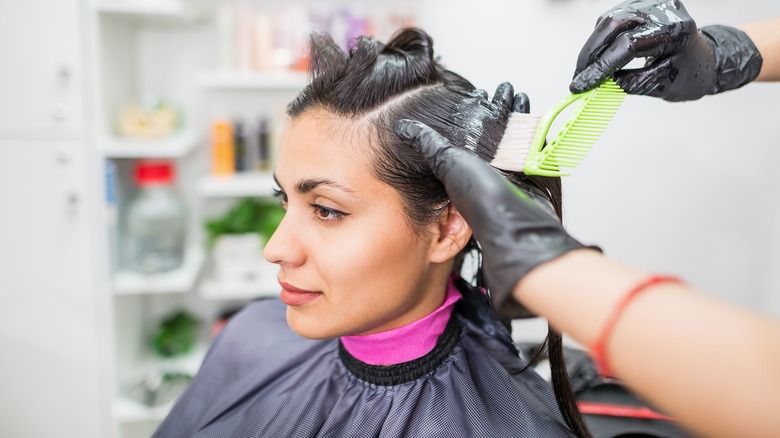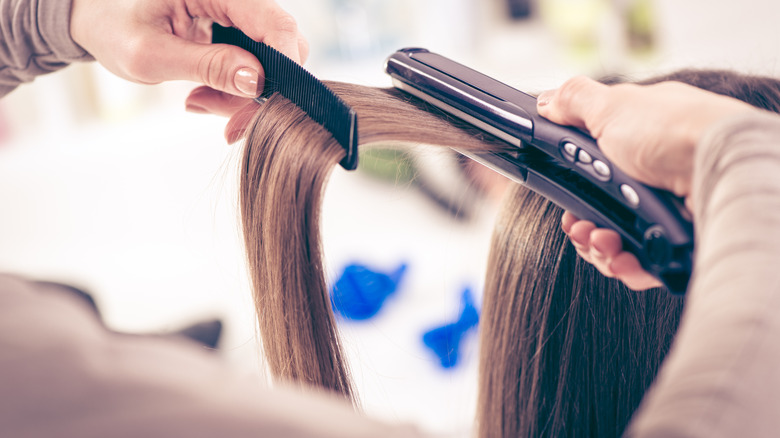Tips For Fixing Your Hair After A Keratin Treatment Gone Wrong
Perfect, luscious, smooth hair has always been the embodiment of beauty. From the ancient Egyptians (who used almond and castor oil to keep the hair moisturized and shiny) to Shakespeare's Elizabethan ladies (who used lard to create the "in" looks) (via MyHairdressers) a closer glimpse into the history of beauty will show this: hair was and will always be a prime concern among wannabe fashionistas. Suffice it to say that during the Great Depression, the beauty industry managed to stay afloat. Even though unemployment soared in the 1930s (with a staggering 25%), the popularity of the bob haircut drove women to splurge and rush to the hair salons to get the looks (via Sinequanon Salons).
Similar hair struggles can be traced in modern times as men and women try to tame fizzy hair. In our attempts to rock the sleek liquid hair look of the likes of the Kardashians, we resort to our hairstylists eager to try new methods. Thanks to pop culture, lustrous, thick, bouncy hair is a must, and we enter a perpetual chase of the perfect coiffure, seeking allies in the haircare industry and tips on viral TikTok videos. Enter Keratin treatments. Unfortunately, not every keratin treatment results in perfectly shiny, sleek locks.
The (odd) origins of the keratin treatment
A keratin treatment is a chemical procedure done by hairstylists and hairdressers to tame unruly hair and give them a smoother look. Keratin is so efficient that it is used as a prime ingredient in several hair care products. Currently, the U.S. is considered the top global exporter of haircare products, including ones that are keratin related. The popularity of keratin is so tremendous that the numbers reported by Straits Research are flabbergasting. More specifically, "the global keratin market was valued at USD 1.2 billion in 2021. It is projected to reach USD 2.03 billion by 2030, growing at a CAGR of 6% during the forecast period (2022-2030)" (via Globenewswire).
But what are the origins of keratin? The hair straightening therapy originated in Brazil, aptly named "Brazilian Keratin." A surprising fact is that keratin was accidentally discovered by a funeral home operator, who, while using chemicals to embalm the bodies, realized that the formaldehyde used resulted in the straightening of the hair (via Brazilian Keratin).
Of course, formaldehyde is not used in today's keratin treatments; similar safer products have gradually replaced it. But how does keratin work to give your hair a long, straight, lush look while reviving your dull locks?
How does keratin work?
Disulfide bonds reside within your hair proteins and are the primary cause of pesky curls. When two sulfur atoms collide, they create a disulfide, curling hair. Even though the number of disulfide bonds in your hair proteins is very much the result of genetics, keratin acts as a barrier between the bonds, breaking them down and hence relaxing the hair, giving them the much sought-after straight look (via AllThingsHair).
The keratin treatment will go through three different processes: relaxing, neutralizing, and conditioning. Our hair's keratinocyte cells already produce keratin (yes!), so an additional keratin coat is applied to the hair during the process of relaxing. This coat bonds with the existing one, protecting the outer hair layer and sealing moisture in your strands, thus taming the fizz. Adding alkalis to the chemicals helps loosen the curl without damaging the hair follicles. Some hair stylists will use a flat iron during the relaxation process, while others will blow dry. However, heat is necessary to seal and activate the chemical coating on the hair strands. The following procedure, neutralizing, involves the restoration of the pH balance of your hair. Keratin may be harmless, but it's still a chemical, so restoring the pH balance ensures that potential damage is controlled. During the last process, conditioning is applied to the hair to leave it silky smooth and shiny!
While keratin can do wonders for coarse hair (and reduce the volume of your natural hair), since it's a chemical process, there is always a slight chance of things going wrong.
What can go wrong?
While most keratin products no longer contain formaldehyde, some products still do (via Healthline), increasing the risk of damaging your hair. In addition, if your hairstylist uses poor-quality products, you might end up with destroyed hair instead of getting the sleek look of your dreams.
Moreover, keratin treatment involves using chemicals (even without formaldehyde) that some brittle hair may not tolerate. If your hair is already thin, dehydrated, and with split ends, keratin will do more harm than good. The same principle goes for hair that has been bleached; typically, hairstylists will refuse to do a keratin treatment on bleached hair.
Even if your hair is in great shape and fine hair, breakage, and dry ends are not concerns you have to deal with (lucky you!), you should still be cautious when opting for a keratin treatment. Hairstylists will use a flat iron at very high temperatures (450˚F) to seal the keratin on your hair strands and bond it with your hair's naturally produced keratin. Unfortunately, this intense temperature could cause damage to your hair, despite the neutralizing and conditioning process that follows (via Philip Kingsley).
So, in your quest for lustrous locks, you might inadvertently end up with a dull, fizzy mane instead. But worry not, because there are ways to fix it.
How to fix it
If you have ever had a keratin treatment gone wrong, you know firsthand how frustrating it is trying to restore your hair's health and vibrancy. If your hair was brittle and thin, keratin gone wrong may be heart-wrenching as you see your hair in an even worse shape than before. However, nothing is permanent, and your hair can recover from a nightmarish keratin outcome.
First stop: trim the ends! Understandably, if you have been trying like crazy to lengthen your hair – and if you resorted to the keratin in the hopes of helping it grow faster – parting ways with your hair's split parts may be a hard choice. But a choice you must make nonetheless. Destroyed ends will do little good for your hair; the only length they add to your locks is a fizzled one.
You also need to invest in some high-quality professional shampoo and bond repair products to ensure that you seal the moisture in your hair and help them bounce back faster. Moreover, once weekly, use a deep mask to nourish the hair and hydrate the strands. Be diligent with your mask haircare routine, and be patient! Results won't show overnight, so persistently moisturize those damaged locks for at least two months. Your hair has already been burned with chemicals, so if you want to revoke the damage, you must avoid flat irons, curling irons, and blow dryers and use a heat protectant.




